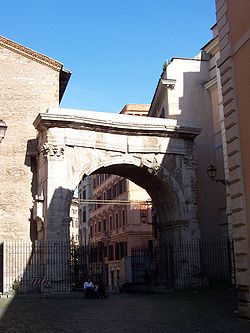
Porta Esquilina
Encyclopedia

Servian Wall
The Servian Wall was a defensive barrier constructed around the city of Rome in the early 4th century BC. The wall was up to 10 metres in height in places, 3.6 metres wide at its base, 11 km long, and is believed to had 16 main gates, though many of these are mentioned only from...
Tradition dates it back to the 6th century BC, when the Servian Wall was said to have been built by the Roman king Servius Tullius
Servius Tullius
Servius Tullius was the legendary sixth king of ancient Rome, and the second of its Etruscan dynasty. He reigned 578-535 BC. Roman and Greek sources describe his servile origins and later marriage to a daughter of Lucius Tarquinius Priscus, Rome's first Etruscan king, who was assassinated in 579 BC...
, however modern scholarship and evidence from archaeology indicates a date in the fourth century BC. The Porta Esquilina is also known as the Esquiline Gate.
Location
The Porta Esquilina allowed passage between Rome and the Esquiline hillEsquiline Hill
The Esquiline Hill is one of the celebrated Seven Hills of Rome. Its southern-most cusp is the Oppius .-Etymology:The origin of the name Esquilino is still under much debate. One view is that the Hill was named after the abundance of holm-oaks, exculi, that resided there...
, at the city’s east. The Esquiline hill served as Rome’s graveyard during the Republic and later as an area for some the emperor’s most beautiful gardens such as the Gardens of Maecenas
Gardens of Maecenas
The Gardens of Maecenas, built by the Augustan era patron of the arts Gaius Maecenas, were the first gardens in the Hellenistic-Persian garden style in Rome...
. Connecting northward to the Esquiline Gate was the agger
Agger
An agger is an ancient Roman embankment or rampart, or any artificial elevation. It is a Latin word.It is especially used for the raised and cambered embankment carrying a Roman road...
, the heavily fortified section of the Servian Wall. Just southwest of the Esquiline Gate were notable locations such as Nero’s Golden House, the Baths of Titus, and Trajan’s Baths. Two major roads, the via Labicana
Via Labicana
The Via Labicana was an ancient road of Italy, leading east southeast from Rome. It seems possible that the road at first led to Tusculum, that it was then extended to Labici, and later still became a road for through traffic; it may even have superseded the Via Latina as a route to the southeast,...
and the via Praenestina, originate at the Porta Esquilina but lead out of Rome as a single road until they separate near Rome's outer, Aurelian wall.
History
Following from the concept of the pomeriumPomerium
The pomerium or pomoerium , was the sacred boundary of the city of Rome. In legal terms, Rome existed only within the pomerium; everything beyond it was simply territory belonging to Rome.-Location and extensions:Tradition maintained that it was the original line ploughed by Romulus around the...
, there seems to be an unofficial Roman “tradition” that certain killings were to be done “outside” of the city and thus several ancient authors include the Esquiline gate in their descriptions of such deeds. For example, in Cic. Pro. Clu. 37 the murder of Asinus of Larinum was done outside the Esquiline gate, and in Tac. Ann. ii. 32, the astrologer Publius Marcius was executed by consuls outside the Esquiline gate.
The Esquiline gate is also mentioned in ancient literature as an important way of entering and exiting Rome. Livy writes about the consul Valarius’s strategic plan to lure out Etruscan pillagers that had been preying on Roman fields. Valarius ordered cattle, which had been previously brought to safety within the city walls, to be sent outside through the Esquiline Gate so that when the Etruscans came down south to seize the cattle, the Romans could ambush the Etruscans from all sides. Cicero, in a speech deemphasizing the greatness of triumph processions, mentions how he trampled his own Macedonian laurels underfoot while entering Rome through the Esquiline gate and this suggests that the Esquiline gate was used for triumph processions. Another example of the Esquiline gate in ancient literature comes from Plutarch’s description of Sulla’s first march on Rome. Sulla ordered the Esquiline gate secured and sent some of his forces to go through it. However, bricks and stones were hurled upon them by citizens that Marius had recruited to defend the city.
Initially, the site of the Porta Esquilina was marked by a single arch that was built in the 1st Century AD, but it later became a triple arch structure in the 3rd Century AD that had a peak height of 8.8m. The conversion to a triple arch was sponsored by the equite M. Aurelius Victor in 262 AD to honor the Roman emperor Gallienus Although archaeological evidence shows signs of extra pillar foundations, Aurelius Victor’s additional arches did not survive and today only the original, single arch remains..

